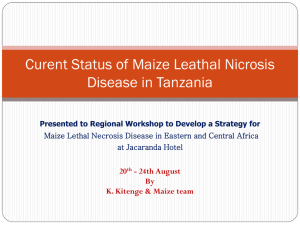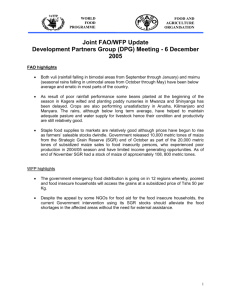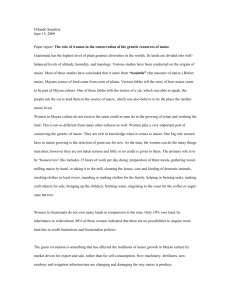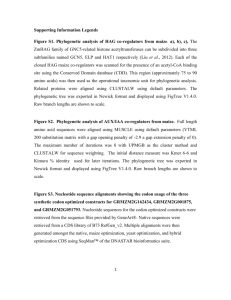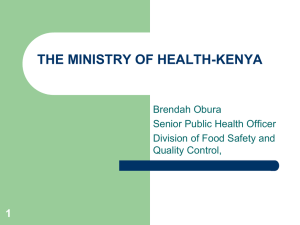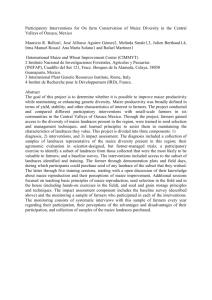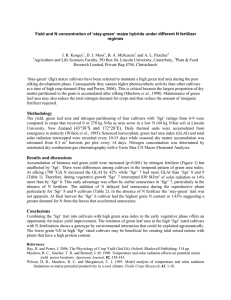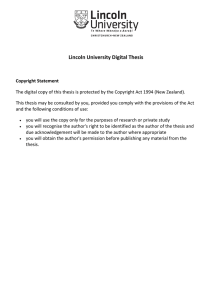Joint FAO/WFP Update
advertisement
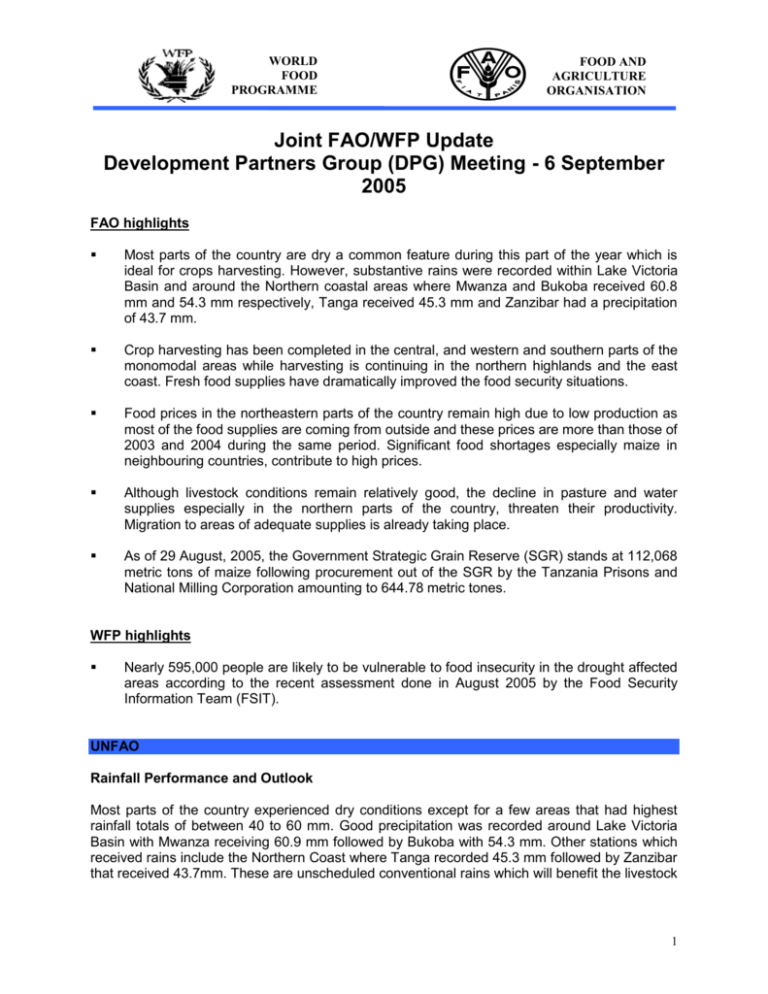
WORLD FOOD PROGRAMME FOOD AND AGRICULTURE ORGANISATION Joint FAO/WFP Update Development Partners Group (DPG) Meeting - 6 September 2005 FAO highlights Most parts of the country are dry a common feature during this part of the year which is ideal for crops harvesting. However, substantive rains were recorded within Lake Victoria Basin and around the Northern coastal areas where Mwanza and Bukoba received 60.8 mm and 54.3 mm respectively, Tanga received 45.3 mm and Zanzibar had a precipitation of 43.7 mm. Crop harvesting has been completed in the central, and western and southern parts of the monomodal areas while harvesting is continuing in the northern highlands and the east coast. Fresh food supplies have dramatically improved the food security situations. Food prices in the northeastern parts of the country remain high due to low production as most of the food supplies are coming from outside and these prices are more than those of 2003 and 2004 during the same period. Significant food shortages especially maize in neighbouring countries, contribute to high prices. Although livestock conditions remain relatively good, the decline in pasture and water supplies especially in the northern parts of the country, threaten their productivity. Migration to areas of adequate supplies is already taking place. As of 29 August, 2005, the Government Strategic Grain Reserve (SGR) stands at 112,068 metric tons of maize following procurement out of the SGR by the Tanzania Prisons and National Milling Corporation amounting to 644.78 metric tones. WFP highlights Nearly 595,000 people are likely to be vulnerable to food insecurity in the drought affected areas according to the recent assessment done in August 2005 by the Food Security Information Team (FSIT). UNFAO Rainfall Performance and Outlook Most parts of the country experienced dry conditions except for a few areas that had highest rainfall totals of between 40 to 60 mm. Good precipitation was recorded around Lake Victoria Basin with Mwanza receiving 60.9 mm followed by Bukoba with 54.3 mm. Other stations which received rains include the Northern Coast where Tanga recorded 45.3 mm followed by Zanzibar that received 43.7mm. These are unscheduled conventional rains which will benefit the livestock 1 WORLD FOOD PROGRAMME FOOD AND AGRICULTURE ORGANISATION as pasture regeneration will occur. Actual observations during the period up to 28 August have maintained a down ward trend which is a normal feature for this time of the year. Food situation Crop harvesting is continuing particularly in the bimodal areas as the operation has come to a conclusion in the south, center and western parts of the country for the monomdal rainfall areas. Food security remains satisfactory across Tanzania as perennial crops harvesting is also peaking up. Banana harvests have steadily improved food supplies in Kagera, Kilimanjaro, Mbeya, and Arusha Region while cassava harvests have contributed to better food situations in Mwanza, Coast, Lindi, and Mtwara Regions. Ten regions which include Mbeya, Rukwa, Ruvuma, Iringa, Morogoro, Mtwara, Kagera, Coast and Tanga, will have surplus food whereas another set of ten regions excluding Dar es Salaam, will face localized shortages due to severe drought. Overall, the crop production trend this season has been more improved compared to last cropping year based on the utilization of inputs and increased hectarage. However, several Districts in the Regions facing food shortages are depending on food supplies from outside which are selling at high prices compared to the same time last year. It is due to traders who are buying large quantities and stocking them for future sales and informal markets being traded with neighbours (such as Kenya) who suffered from severe drought. Food shortages were identified in thirty nine (39) Districts in twelve (12) Regions which had experienced poor rains during the last cropping season (2004/2005). A Rapid Vulnerability Assessment (RVA), was carried out from 31 July to August, 13 by the Food Security Information Team (FSIT) in forty Districts that were earlier preliminarily forecasted by the Ministry of Agriculture and Food Security (MAFS) to be hit by drought. The Districts include Karatu, Monduli, Arumeru and Ngorongoro ( Arusha Region), Dodoma Rural, Kondoa, Mpwapwa and Dodoma Urban (Dodoma), Iringa and Kilolo (Iringa), Same, Mwanga, Hai, Moshi Rural (Kilimanjaro), Ruangwa, Kilwa, Lindi Rural and Liwale (Lindi), Simanjiro (Manyara), Bunda, Musoma and Tarime (Mara), Masasi (Mtwara), Misungwi, Magu, and Kwimba (Mwanza), Meatu and Maswa (Shinyanga), Singida, Manyoni and Iramba (Singida), Igunga, Tabora Urban and Sikonge (Tabora). The options of interventions recommended for nearly 600,000 people, include the provision of subsidized food and seeds assistance (about 20,000 mt. and 1189 mt. of food and seeds respectively) to the most destitute who have their food and seeds stocks exhausted due low production which was below 30% of the normal harvests and would not be able to stretch any further for their survival with the limited copping strategies from November onwards. In most of urban markets, maize prices have been on the increase compared to 2003 and 2004 market years for the corresponding months and expectations were that prices would decline with the current harvests between June and September. The average maize prices in August were highest in the northern highlands and lowest in the southern highlands and central where harvesting is completed. A bag of 100 kg. of maize is selling at between TShs 22,000/= and TShs 24,000/= in the northern highlands while elsewhere in Lindi, Mtwara, Musoma and Mwanza, a similar bag of 100 kg. is costing about 20,000/=. Traders view the current production as being below average and recognize the surging maize demands exerted by shortages in neighbouring Kenya, Malawi and Zambia. The maize prices suggest that the poor households which were declared vulnerable by the August RVA report, will face increasing difficulty in accessing adequate supplies, hence, the need for subsidized food As the dry season progresses following the cessation of the rains, vegetation is also fast drying and declining in supply. The situation is much worse in the pastoral northern highlands 2 WORLD FOOD PROGRAMME FOOD AND AGRICULTURE ORGANISATION especially in Ngorongoro, Monduli, Kiteto, and Simanjiro in Arusha and Manyara Regions, agropastoral areas in Kilimanjaro, Morogoro (eastern) and Iringa (southern). However, there are no reports of livestock deteriorations in productivity although migration for better pasture is occurring in Kilimanjaro and Arusha regions. Strategic Grain Reserve The Strategic Grain Reserve (SGR) stocks stand at 112,068 metric tons as of today 29 August, 2005 after sales were made by the Tanzania Prisons and National Milling Corporation which a total of 644.78 from July,2005. The SGR has more than adequate stocks to cover the desired 20,000 mt. for the vulnerable population identified during the Rapid Vulnerability Assessment. UNWFP Food Security Situation Report The Food Security Information Team (FSIT) has submitted the food security assessment report to the Government for implementation. The assessment was carried out in August 2005 in 39 drought affected districts. The report indicates significant improvement of the food situation in the country during the 2005/06 marketing year, for the second consecutive year. However, localized food shortages are likely to exist in some drought prone areas of the north-east, central and western parts of the country. According to the FSIT report, nearly 595,000 people are likely to face food shortages during the lean period of November 2005 to January 2006, if appropriate measures are not taken in a timely manner. The report further recommends market intervention through sale of maize from Government reserve (SGR) at a subsidized price. About 20,000 MT maize will be required for distribution between November and January next year. Currently, the government owned SGR is stocked with 112,068 MT maize in its 6 zonal centers. 3
